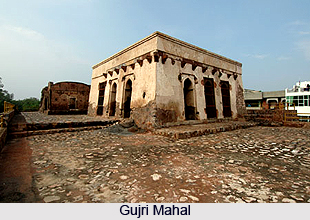 Gujri Mahal is a beautiful palace which was constructed by Firoz Shah Tughlaq for his wife named `Gujri` and is based outside the main palace complex in the city of Hisar, Haryana during 1354 AD. Currently, the palace lies in ruins though it`s raised platform or `baradari` which was once utilized for social gatherings is in better condition. The raw materials employed to create the structure is said to have been seized from several Hindu temples which were destructed by the Mughals. Unfortunately, the palace cannot be approached by the public. The Archaeological Survey of India or ASI has declared the monument as a Centrally Protected Monument.
Gujri Mahal is a beautiful palace which was constructed by Firoz Shah Tughlaq for his wife named `Gujri` and is based outside the main palace complex in the city of Hisar, Haryana during 1354 AD. Currently, the palace lies in ruins though it`s raised platform or `baradari` which was once utilized for social gatherings is in better condition. The raw materials employed to create the structure is said to have been seized from several Hindu temples which were destructed by the Mughals. Unfortunately, the palace cannot be approached by the public. The Archaeological Survey of India or ASI has declared the monument as a Centrally Protected Monument.
Legend of Gujri Mahal
Gujri was the wife of the Sultan, Firoz Shah Tughlaq and was a regional inhabitant of Hisar. Historical sources have claimed that once when the Sultan requested her company at his throne in Delhi, she refused to accept. Therefore, he had constructed a palace for his wife in Hisar, close to his personal residential palace. It is said that he had met Gujri, a Gujjar girl, during a hunting expedition and he was instantly charmed by her beauty. However, after their marriage Gujri had not agreed to accompany her husband to Delhi fearing she might be treated with contempt by his other wives.
Architecture of Gujri Mahal
Mortar and rubble were utilized to build the Gujri Mahal and its pillars were established by using materials taken from some Hindu and Jain temples. However, just a tiny part of the grand palace lies intact today and the palace stands on a rectangle-shaped platform. Only the baradari of the palace is unscathed and consists of 12 doors, three present on each of its side. Four pillars in the room are strong foundations which support the terrace. Under the platform are existent three underground chambers. A tank is present here, which is said to have been used for the purpose of bathing by Gujri. One will notice nine graves on the platform but are not a part of the original palace. Two of them are brick shrines while seven graves out of them are sarcophagi and can be dated to the 17th or the 18th century.
A series of stairs leading to the baradari or platform is present. All entrances to Gujri Palace are equipped with stone door frames with the exception of one. Carved red sandstone brackets are there over the arched openings of the structure. Nine bays adorn the terrace, each with a beautiful hemispherical dome, beautified by panel work in lime plaster.



















